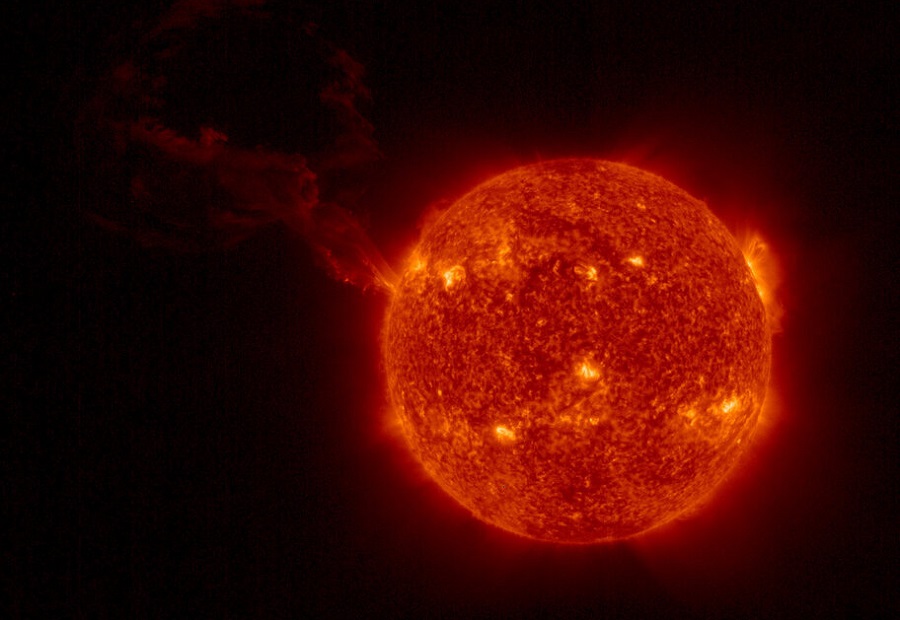
A spacecraft jointly operated by European (ESA) and American (NASA) space agencies have captured the largest solar prominence eruption ever observed; the February 15 eruption was significant, but unrelated to an ongoing Geomagnetic Storm Watch that remains in effect for tomorrow.
The ESA/NASA Solar Orbiter spacecraft captured the massive explosion in a single image together with the full disc. A solar prominence is a large structure of tangled magnetic field lines that keep dense concentrations of solar plasma suspended above the Sun’s surface; the magnetic field lines will help shape these eruptions into the form of arching loops sometimes. Often associated with a coronal mass ejection (CME), these massive eruptions from the sun could have significant impacts to Earth and the technology that orbits around it.
This composition of imagery is from the ESA/NASA Solar Orbiter & SOHO spacecraft, which captured a GIANT solar eruption on this week on February 15. pic.twitter.com/RKXaf76k0u
— the Weatherboy (@theWeatherboy) February 19, 2022
Fortunately, this massive eruption from the sun did not send a blast of deadly particles towards Earth. Instead, this February 15 CME was directed away from Earth. Based on an analysis of the imagery, ESA said, “it must have originated from the side of the Sun facing away from us.”
While the Earth escaped impacts from this eruption, it may not be as lucky in the future. And in the near future, another coronal hole is expected to bring about geomagnetic storm conditions tomorrow. Due to that space weather event, government forecasters have raised a Geomagnetic Storm Watch for Sunday.
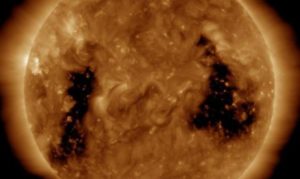
In their latest space weather forecast discussion, NOAA’s Space Weather Prediction Center (SWPC) says, “Mostly quiet conditions are expected through approximately midday on February 20 under nominal solar wind conditions.” But they add, “Approximately midday on February 20, an extension of the southern crown polar coronal hole is expected to become geoeffective causing unsettled to G1 (Minor) storm levels.”
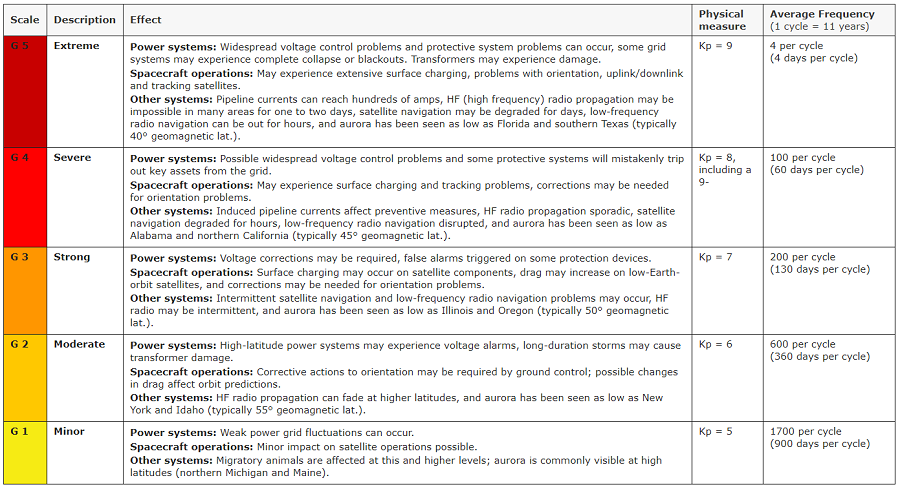
The SWPC says that during a G1-class storm event, power grid fluctuations can occur on Earth while in space, satellite orientation irregularities could occur. Communications can also be hampered: high frequency (HF) radio propagation can fade at higher latitudes. Elsewhere, Mother Nature may light up the skies more south than usual; aurora could be visible as low as Michigan to Maine.
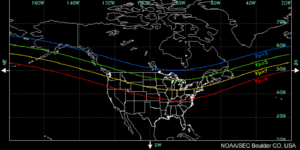
The K-index, and by extension the Planetary K-index, are used to characterize the magnitude of geomagnetic storms. The SWPC says that Kp is an excellent indicator of disturbances in the Earth’s magnetic field and is used by SWPC to decide whether geomagnetic alerts and warnings need to be issued for users who are affected by these disturbances. Beyond signifying how bad a geomagnetic storm’s impact can be felt, the Kp index can also help indicate how low the aurora will be. For now, a Kp index of 5 is expected late on February 20.
This forecast storm is one of a growing number of such storms to impact Earth in recent weeks. Earlier this month, a geomagnetic storm was responsible for the destruction of dozens of satellites launched by SpaceX. On February 3, SpaceX launched its Falcon 9 rocket into space from NASA’s Kennedy Space Center in Florida. In a statement addressing the issue, SpaceX wrote, “Falcon 9’s second stage deployed the satellites into their intended orbit, with a perigee of approximately 210 kilometers above Earth, and each satellite achieved controlled flight. SpaceX deploys its satellites into these lower orbits so that in the very rare case any satellite does not pass initial system checkouts it will quickly be deorbited by atmospheric drag. While the low deployment altitude requires more capable satellites at a considerable cost to us, it’s the right thing to do to maintain a sustainable space environment.” However, they added how this approach in a geomagnetic storm led to many of the satellites demise: “Unfortunately, the satellites deployed on Thursday were significantly impacted by a geomagnetic storm on Friday. These storms cause the atmosphere to warm and atmospheric density at our low deployment altitudes to increase. In fact, onboard GPS suggests the escalation speed and severity of the storm caused atmospheric drag to increase up to 50 percent higher than during previous launches. The Starlink team commanded the satellites into a safe-mode where they would fly edge-on (like a sheet of paper) to minimize drag—to effectively “take cover from the storm”—and continued to work closely with the Space Force’s 18th Space Control Squadron and LeoLabs to provide updates on the satellites based on ground radars.”
According to a preliminary analysis made by SpaceX, it appears the increased drag at the low altitude doomed up to 40 satellites, with those satellites re-entering or already re-entered the Earth’s atmosphere. SpaceX advised, “The deorbiting satellites pose zero collision risk with other satellites and by design demise upon atmospheric reentry—meaning no orbital debris is created and no satellite parts hit the ground.”
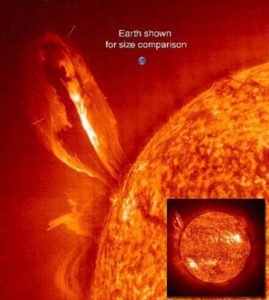
While the number appears to be a significant loss, it isn’t that significant in the overall quantity of Starlink satellites SpaceX has in orbit. The current Starlink constellation is authorized for 4,408 satellites; there are over 2,040 of them in orbit today.
While these solar events can help illuminate the sky with stunning aurora and threaten spacecraft like the SpaceX satellites above the Earth, they can also do considerable harm to electronics, electrical grids, and satellite and radio communications on Earth.
The 1859 incident, which occurred on September 1-2 in 1859, is also known as the “Carrington Event.” This event unfolded as powerful geomagnetic storm struck Earth during Solar Cycle 10. A CME hit the Earth and induced the largest geomagnetic storm on record. The storm was so intense it created extremely bright, vivid aurora throughout the planet: people in California thought the sun rose early, people in the northeastern U.S. could read a newspaper at night from the aurora’s bright light, and people as far south as Hawaii and south-central Mexico could see the aurora in the sky.
The event severely damaged the limited electrical and communication lines that existed at that time; telegraph systems around the world failed, with some telegraph operators reporting they received electric shocks.
A June 2013 study by Lloyd’s of London and Atmospheric and Environmental Research (AER) in the U.S. showed that if the Carrington event happened in modern times, damages in the U.S. could exceed $2.6 trillion, roughly 15% of the nation’s annual GDP.
Scientists believe that another Carrington-like event will occur, but not sure when it’ll happen. Scientists believe we are now in a period of increasing solar storm activity which is forecast to peak in 2025. While an increase in solar cycle sunspots was expected in this new cycle, the amount of activity has exceeded forecasts, especially in 2021 and so far in 2022. Experts believe the cycle will peak-out around 2025, with even more space weather events unfolding between now and then. It is possible a Carrington-like event could happen at anytime, although odds could be highest during the peak cycle around 2025.
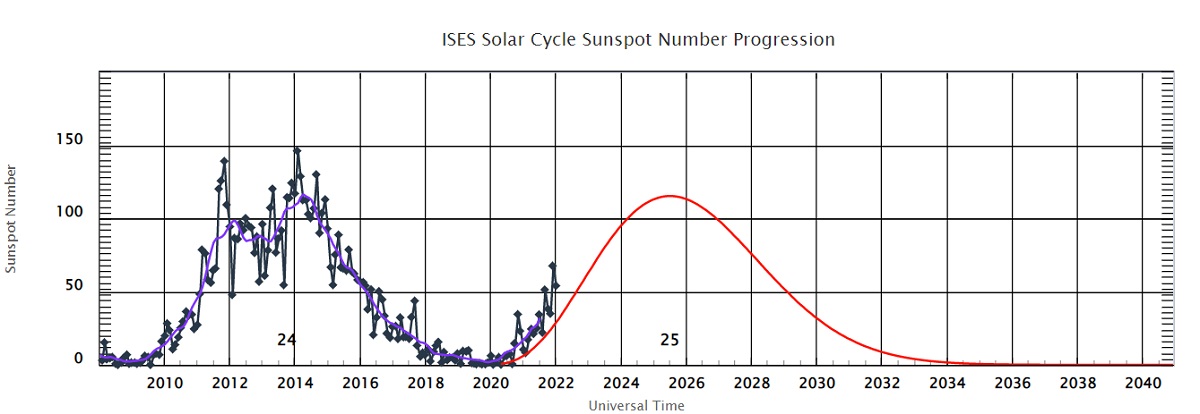
Solar storm activity continues to increase, with activity somewhat more frequent than was forecast to be in this latest solar cycle. While the Geomagnetic Storm Watch up this weekend is for a G1-class storm, scientists continue to warn that the frequency and intensity of these geomagnetic storms are likely to increase; it is also possible that future storms could significantly impact life on Earth.
Some scientists believe a larger space weather event could be extremely disruptive on earth, shutting down the electrical grid and bringing an end to the internet for a month or longer. A paper written last September by University of California assistant professor Sangeetha Abdu Jyothi, entitled “Solar Superstorms: Planning for an Internet Apocalypse”, describes the threats the sun pose to the global web of computers and the communications between them. “In this paper, we investigate the impact of solar superstorms that can potentially cause large-scale Internet outages covering the entire globe and lasting several months,” the author wrote.
NOAA forecasters analyze a variety of solar data from spacecraft to determine what impacts a geomagnetic storm could produce. If Earth is experiencing the effects of a coronal hole and a coronal mass ejection is forecasted to impact Earth, the combined effects could result in a more significant impact and more intense geomagnetic storming. Analyzing data from the DSCOVER and ACE satellite is one way forecasters can tell when the enhanced solar wind from a coronal hole is about to arrive at Earth. A few things they look for in the data to determine when the enhanced solar wind is arriving at Earth:
• Solar wind speed increases
• Temperature increases
• Particle density decreases
• Interplanetary magnetic field (IMF) strength increases
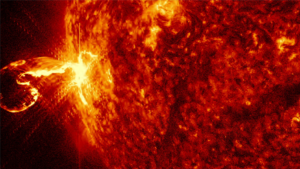
Until that happens, NOAA’s Space Weather Prediction Center continues to keep an eye out for possible dangers from the Sun.
While typically known for their weather forecasts, the National Oceanic and Atmospheric Administration (NOAA) and its National Weather Service (NWS) is also responsible for “space weather.” While there are private companies and other agencies that monitor and forecast space weather, the official source for alerts and warnings of the space environment is the Space Weather Prediction Center (SWPC). The SWPC is located in Boulder, Colorado and is a service center of the NWS, which is part of NOAA. The Space Weather Prediction Center is also one of nine National Centers for Environmental Prediction (NCEP) as they monitor current space weather activity 24/7, 365 days a year.

Image: NASA/Mary Pat Hrybyk-Keith